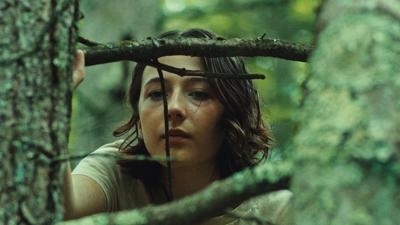The father-daughter relationship just might be one of the hardest connections to navigate, and unfortunately, there’s no trail map. Beyond the obvious generational divide, the dynamic is famously cursed with emotional rifts — fathers taught not to feel, and daughters who don’t know how not to. It’s like “trying to squeeze water out of a rock.”
Good One is the debut feature from director India Donaldson, daughter of Thirteen Days director Roger Donaldson. The film follows 17-year-old Sam as she embarks on a long weekend hiking trip with her father and his longtime best friend, and it received critical acclaim during this year’s Cannes and Sundance film festivals. Maybe some true film buffs don’t watch trailers, but if you usually do, skip this one. It’s not laden with spoilers, but it frames the plot as that of a thriller with a big, sinister twist. Sure, Good One centers on three hikers alone in the woods and struggling to communicate, but this is no Blair Witch Project. There are a few articles floating around the internet promising to explain the “twist ending,” but don’t be misled — the events these articles refer to will feel inevitable to many, especially those who relate to the main character. M. Night Shyamalan is not in the room with us! You could say the third act confirms a suspicion, at most.
Filmed on location in the Hudson Valley, scenes of tense dialogue are intercut with breathtaking glimpses of the surrounding woods. Arguments melt into shots of streams and bright-orange salamanders, contrasting the complexity of the personalities at play with the peaceful wilderness.
It’s hard to outshine the grandeur of the stunning setting, but newcomer Lily Collias brings gravitas to the film’s wiser-than-her-years protagonist. It’s her film, and she makes it work in a way that many of today’s talented young stars could only dream of. James Le Gros and Danny McCarthy round out the film’s leading trio, bringing their rowdy father characters to life with almost painful realism.
Dialogue is sparse in Good One, letting the natural tension of silence do much of the talking. So much of the film’s text is understood through glances and motion. This is where Collias as Sam truly shines — in one pivotal scene, she says very little, but in her expressions alone lets down her guard, only to build it back tenfold after a single sentence. It’s chilling, and the moment cements Collias’ star power. Expect her to be an A24 or Neon darling by 2026!
Even the film’s beautifully captured natural light and sound design — which sounds straight out of a nature-sounds CD kiosk from 2006 — can’t take away from the darkness of the plot. Donaldson’s understanding of Sam’s experience breathes life into the plot, especially in the film’s darker moments. Threats of comparison, issues of trust and fraught communication plague the central relationship between Sam and her father. It’s difficult for Sam and the viewer alike to perceive which if any of the film’s other characters may be a threat to her, and which are innocent comedic relief — from her dad’s bumbling college friend Matt to the oafish “tarot bros” her co-hikers invite to camp with them along the trail.
A full-circle ending brings a hint of satisfying closure to the complicated relationship at the heart of Good One. In many ways, the film serves as a female gaze at the male gaze, exploring the emotional weight families carry, the universal adolescent experience of learning who to trust, and the rocky trails we blaze in finding peace within it all.





